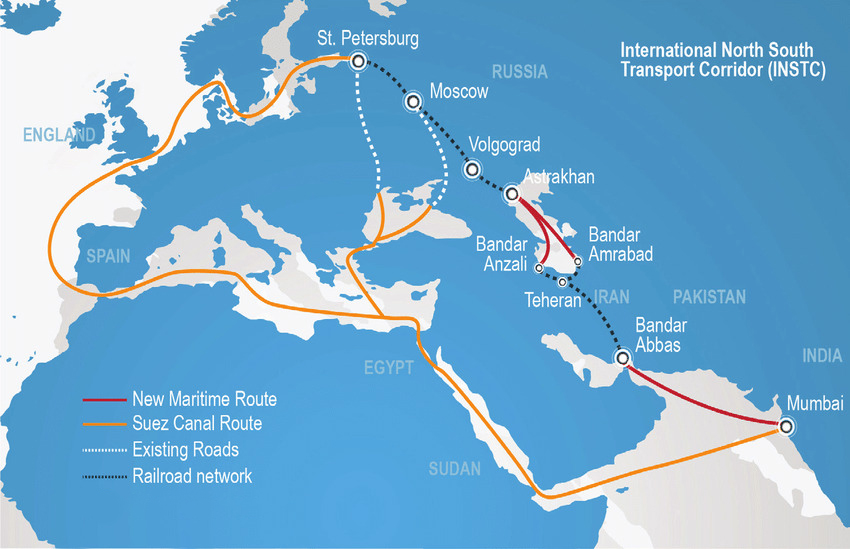With rapidly changing dynamics in Afghanistan since the U.S. troops withdrawal, many longstanding projects, ambitions, and hopes are expected to go through a complete turnaround. While China is now looking at brighter prospects for connecting Afghanistan with the China-Pakistan Economic Corridor (which is an arm for the Belt and Road Initiative), India is now staring at the vanishing prospects for directly linking Afghanistan through an eastern branch of the International North-South Transport Corridor (INSTC). In a recent development it has been conveyed that a Taliban-controlled Afghansitan will not be a part of the quadrilateral grouping comprising of Iran, India and Uzbekistan to discuss the use of Chabahar port later this year. However, the question remains whether the eastern corridor can see the light of day now, given how Taliban has shown affinity towards cooperation and business with Beijing.
INSTC is a 7200 km long multimodal network of ship, rail, and road route for moving freight between India, Iran, Azerbaijan, Russia, and Central Asia. It was envisioned in 2000 and since an agreement in 2002 between Iran, India and Russia, the network has been in development. With a successful dry run in 2014 through Iran, Azerbaijan and Russia for identifying bottlenecks and challenges, the western wing of the INSTC became operational in June this year, with a consignment dispatched by a Finnish logistics company to reach India.
In comparison to an average time of 35-40 days for cargo containers travelling between Mumbai (India) and St. Petersburg (Russia), the time through the INSTC falls to 20-22 days. For India, the operationalization and success of INSTC will lead to tapping of new markets and access to energy resources from Central and North Asian markets which till now have lagged due to accessibility issues. Further, INSTC is envisioned to get synchronized with other corridors like the Scandinavian-Mediterranean corridor and the upcoming North Sea Route, thus making the INSTC a scalable connectivity project.
The Eastern Corridor
While the western corridor is envisioned under the Ashgabat agreement between India, Oman, Turkmenistan, Uzbekistan and Kazakhstan, a proposal by India envisioned an eastern corridor via Kabul (Afghanistan) to Tashkent (Uzbekistan) via Iran’s Chabahar port (whereas Iran’s Bandar Abbas port is utilised otherwise). To this aim, India, Iran, and Afghanistan had signed agreement in 2016 for developing Iran’s Chabahar port and setting up a trilateral corridor. For India, the eastern corridor would not only have maximized the INSTC’s potential but would also have served as a geopolitical win for India by decreasing Afghanistan’s dependence on Pakistan as an intermediary to use land route for trade with India. Simultaneously, India would have hoped to enhance connectivity with Central Asian markets which India has been deprived of by Pakistan since long.
With recent developments however, the eastern corridor plan looks in stormy skies. While an argument can be made that Indian trade with Afghanistan continued even during the previous phase of Taliban’s rule from 1996-2001, the presence of China unlike last time as an enormous producer, consumer and geopolitical player in subcontinent unlike last time, with direct accessibility to Afghanistan via Pakistan, is going to be too much for India to compete with. Beijing has already established close ties with the emergent Taliban and is widely speculated to become the first nation to formally recognize it as the legitimate government in Afghanistan.
Further, Gwadar port in Pakistan which serves as a key element in the CPEC project, will undergo a doubling in its tonnage capacity per year which dwarfs the capacity of Chabahar port in Iran which lies at the core of the India’s objective. It has been argued by many experts in recent years that South Asia is set to witness a growing competition between China and India, for influence over the smaller South Asian nations. Considering the emerging situation in Afghanistan, it would not be unconceivable that this might be curtains for India’s hopes for a substantial presence in Afghanistan’s market. While the United States’ withdrawal will make way for cheaper and readily available Chinese goods, India might be forced to focus on the western corridor nations for trade.
Conclusion
Taliban has stated that under its rule, Afghanistan wants better diplomatic and trade relations with all countries. Even if sanctions would be imposed by US and EU on trade with Taliban-ruled Afghanistan, India’s trade with Afghanistan might still happen as India majorly exports pharmaceuticals, sugar, and many other essential goods, while India imports dry fruits, resins, and apples. Recently, Federation of Indian Export Organizations (FIEO) stated that Taliban has stopped all imports and exports from India through Pakistan’s routes, however, Indian export to Afghanistan via Chabahar route is still taking place. But with China taking steps to increase footprint in the region through CPEC, it will be a tough case for eastern corridor’s success. Even if the connectivity issues are resolved, competing with a China having logistically better access to Afghanistan and warm relations with Taliban, will remain a herculean task for India.

